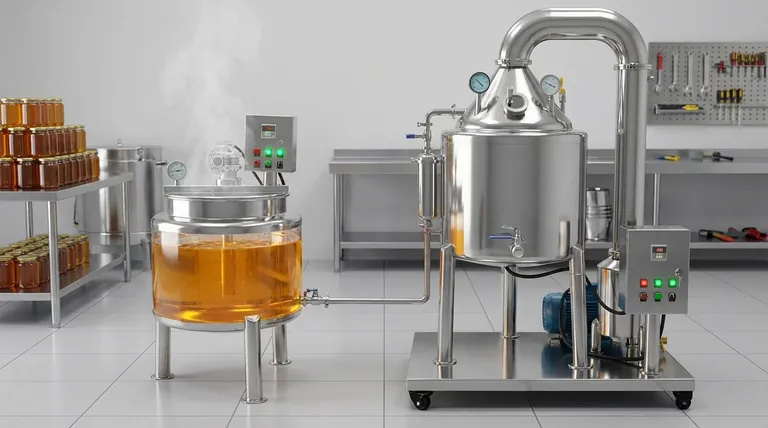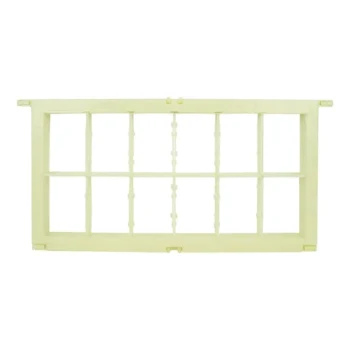In short, a honey heating tank dramatically improves filtration. By gently warming the honey, it lowers its viscosity, allowing it to flow easily through fine filters. This process efficiently removes impurities like wax particles and bee parts, resulting in a crystal-clear product that is far more appealing to consumers.
The core function of a honey heating tank is to make honey less thick for easier filtering. However, its true value lies in achieving this efficiency with controlled, gentle heat that preserves the honey's natural flavor, aroma, and beneficial qualities.

The Core Principle: Why Heat is a Game-Changer for Filtration
To understand the benefit of a heating tank, we must first look at the physical properties of honey. Raw honey is thick and resistant to flowing, which makes removing small particles exceptionally difficult.
Overcoming Viscosity
Honey's natural thickness, or viscosity, is the primary barrier to effective filtration.
Applying gentle, controlled heat makes the honey significantly more fluid. This allows it to pass through strainers and filters with minimal resistance.
Enhancing Debris Removal
A more fluid honey can pass through much finer filters.
This enables the removal of even the smallest impurities, including wax particles, bee parts, pollen, and other debris that would otherwise remain suspended in the final product.
Achieving Crystal-Clear Clarity
Efficient filtration is the key to a visually perfect product.
By removing fine particles and tiny sugar crystals that cause cloudiness, the process yields a clear, brilliant honey. This clean appearance is a major factor in marketability and customer perception of quality.
Beyond Filtration: The Broader Operational Benefits
While improved filtration is the main goal, using a honey heating tank introduces significant efficiencies across the entire production workflow.
Accelerating the Entire Workflow
Heating and filtering is much faster than waiting for honey to pass through a filter at room temperature.
This acceleration streamlines the entire process, from extraction to bottling. For larger operations, many tanks are designed for continuous use, creating a steady and highly productive workflow.
Improving Consistency and Quality
Controlled heating and filtering ensures a uniform product batch after batch.
This process results in a consistent texture and appearance, free from the larger particles and air bubbles that can detract from quality.
Enabling Larger Scale Production
For any operation beyond a small hobbyist, a heating and filtering system is a necessity.
It allows a producer to handle a significant volume of honey quickly and cost-effectively, making it an essential tool for scaling up a beekeeping business.
Understanding the Trade-offs: The Critical Role of Controlled Heat
Heating honey is a powerful tool, but it must be managed correctly. The primary risk is damaging the very product you are trying to improve.
The Risk of Overheating
Excessive or uncontrolled heat can be destructive to honey.
It can degrade the delicate enzymes and beneficial compounds, as well as negatively alter the natural flavor and aroma profile that makes honey unique.
Gentle, Controlled Heating is Key
The main advantage of a dedicated honey heating tank is temperature control.
These systems are designed to apply gentle, even warmth. This preserves the honey's natural properties while still providing the viscosity reduction needed for effective filtration.
Making the Right Choice for Your Goal
Integrating a honey heating tank is a strategic decision that depends on your specific operational goals.
- If your primary focus is maximizing product marketability: A heating tank is essential for achieving the crystal-clear, pure appearance that most consumers associate with high-quality honey.
- If your primary focus is preserving raw honey's natural state: You must prioritize a tank with precise and reliable temperature control to avoid degrading beneficial enzymes and compounds.
- If your primary focus is operational efficiency and scale: The tank becomes the core of a streamlined workflow, dramatically increasing your processing speed and potential volume.
Ultimately, a honey heating tank gives you precise control over the crucial balance between processing efficiency and final product quality.
Summary Table:
| Benefit | Key Impact |
|---|---|
| Improved Filtration | Reduces viscosity for efficient removal of wax, bee parts, and debris. |
| Faster Workflow | Accelerates processing from extraction to bottling. |
| Enhanced Product Quality | Ensures crystal-clear, consistent honey with preserved flavor. |
| Scalable Production | Enables handling of large volumes for commercial operations. |
Ready to streamline your honey processing and enhance product quality?
HONESTBEE supplies professional-grade honey heating tanks and beekeeping equipment to commercial apiaries and distributors. Our wholesale-focused operations ensure you get the reliable, efficient tools needed to scale your business while preserving the natural quality of your honey.
Contact HONESTBEE today to discuss your specific needs and discover the right equipment for your operation.
Visual Guide

Related Products
- Honey Concentrating and Filtering Dehumidifier Machine 2T Capacity for Honey
- Beeswax Melter for Candle Making Honey Bee Wax Melter
- Honey Tank Heater Drum Heating Blanket for Honey Barrel
- Electric Honey Press Machine for Squeezing Honey Comb Press Equipment
- Stainless Steel Triangle Support Honey Strainer and Filters
People Also Ask
- How does centrifugation work in honey extraction? The Sustainable Method for Modern Beekeepers
- What are the benefits of using a honey dryer for honey production? Boost Yield & Quality
- How to decrease moisture in honey? Prevent Fermentation and Ensure Long-Term Quality
- What principle does the honey vacuum thickener use to concentrate honey? Preserve Quality with Low-Temperature Evaporation
- What is the humidity extraction capability of the honey dryer? Achieve Perfect Honey Moisture Control



















